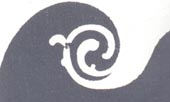
ギリシア美術の様式
幾何学様式 Ⅱ
![]() 幾何学様式(古代ギリシア藝術)続きです
幾何学様式(古代ギリシア藝術)続きです
『デピュロンの壺』
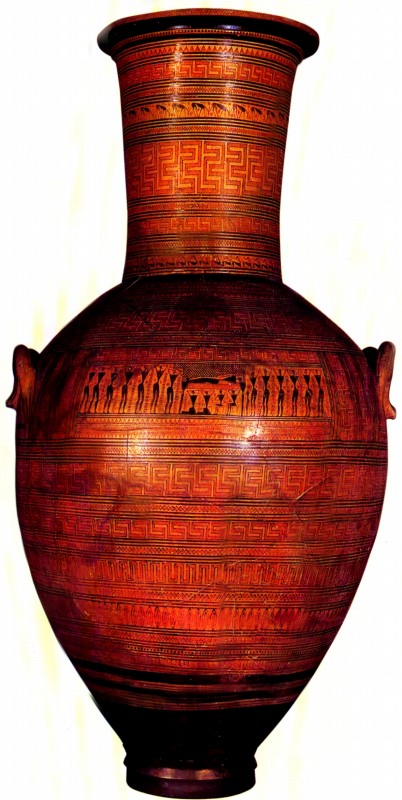
図39 後期幾何学様式のアンフォラ 葬礼儀式の場面
アテナイ ディピュロン墓地出土 前750年頃
アテナイ 国立考古美術館
骨の容器ではなく墓標(セーマタ)として
墓の上に立っていた、
巨大な墓標アンフォラの最も初期の例の一つ
ナイジェル・スパイヴィ『ギリシア美術』
~ゴンブリッチの『美術の物語』(図46) ~
The mourning of the dead,c.700 BC ; 《幾何学文の壷》
Greek vase in the Ceometrid style;height 155cm ,61in;National Archaeological Museum,Athens
 これが『デピュロンの壺』だが、ゴンブリッチの説明は、厳格な幾何学様式のデザインの間に、以下の様なシーンの場所をもつ、という、普通の淡々とした感じ・・
これが『デピュロンの壺』だが、ゴンブリッチの説明は、厳格な幾何学様式のデザインの間に、以下の様なシーンの場所をもつ、という、普通の淡々とした感じ・・
Their pottery was decorated with simple geometric patters,and where a scene was to be reprezented it formed part of this strict design.
棺台の上に横たわる死者と、ほぼすべての原始社会で共通する、死者の左右の女性たちの頭に手を上げて悼む儀式の図があるといった説明。
He is lying on his bier,while wailing women right and left raise their hands to their heads in the ritual lament which is the custom in nearly all primitive societies.
頸部の上部

メアンダー鍵や他の抽象モティーフの多数の帯の間に一列に並んで横たわった鹿や草を食む鹿の行列が入り込んでいる
※横たわった鹿 の方はよくわからないが上の列の
食む形はよくわかる

中心部パネル
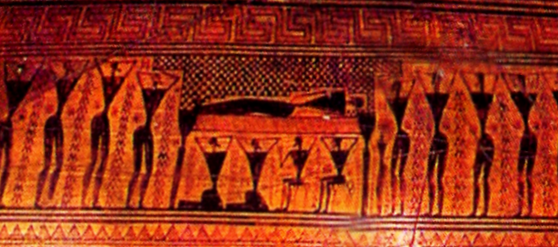
プロテシス(告別のための遺体安置)
市松文様はプロテシスの間遺骸を覆うために用いられた織物のブランケットに違いない。(p76)

図44 後期幾何学様式 アテナイ出土 前8世紀 高さ30cm
ニューヨーク メトロポリタン美術館
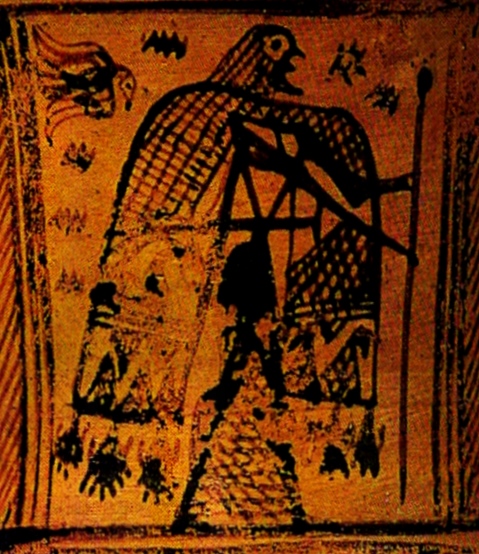
プロテシスのブランケットを運ぶ
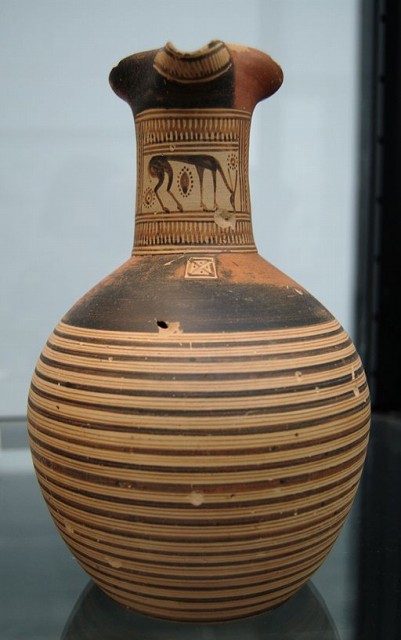
Oinochoe (wine jug). On the neck: grazing roe-deer, Dipylon Master style. Attica, ca. 750 BC. ミュンヘンStaatliche Antikensammlungen蔵
前8世紀初頭のアテナイにおいて、かってディピュロン墓地の墓の目印となっていた陶器がその器面に形象絵画をもっていたことには、陶器の目的が墓標、いい替えれば記念柱であることを補足する役割があったためである。
ナイジェル・スパイヴィ『ギリシア美術』(p76)
![]() ここでちょっと休憩ですwww
ここでちょっと休憩ですwww
※ポートランド州立大学 ※Geometric Greek Pottery
「子供のための歴史」でお薦めの本
http://www.historyforkids.org/learn/greeks/art/pottery/geometric.htm
Early Greek Vase Painting: 11Th-6Th Centuries Bc:
A Handbook (World of Art) by John Boardman (1998)
John Boardman(art historian) 1927年生まれ。
古代ギリシアの美術・考古学の権威。オックスフォード大学名誉教授
http://proteus.brown.edu/greekpast/
The Archaeology of Greece: An Introduction, by William R. Biers (1996)..
Greek Art and Archaeology (5rd Edition), by John G. Pedley (2002)
Hirschfeld Krater(アテネ)
![]() アテネの国立美術館の「ヒルシュフェルトのクラテル」展示です。
アテネの国立美術館の「ヒルシュフェルトのクラテル」展示です。
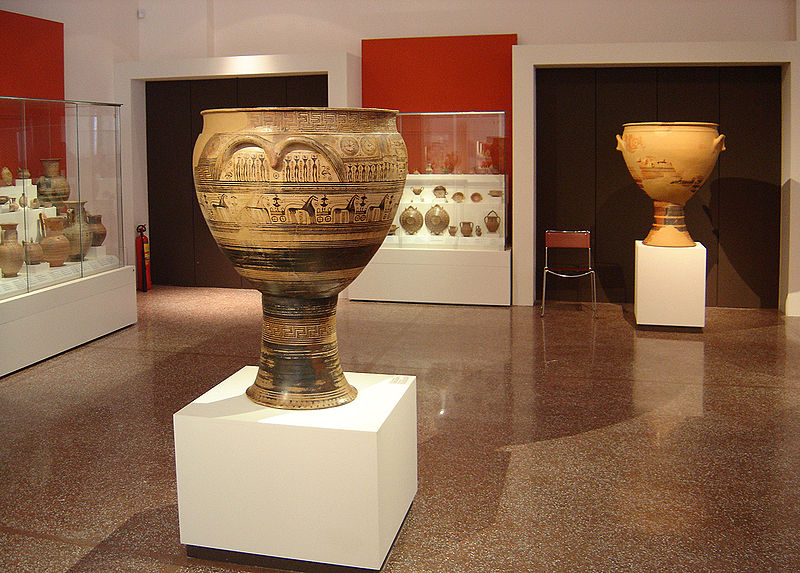
Attic geometric krater. From Dipylon, Kerameikos.
By Hirschfeld Painter. 750-735 B.C.
ケラメイコス出土 アテネ国立考古博物館蔵
National Archaeological Museum, Athens Α 00990
Attic late geometric krater depicting ekphora, the act of carrying a body to its grave.
http://www.namuseum.gr/collections/vases/geom/geometrical04-en.html
The Hirschfeld Krater, mid-8th century BC,
from the late Geometric period, depicting ekph
ora,
the act of carrying a body to its grave.
National Archaeological Museum, Athens.
Hirschfeld painter.
※Hirschfeld painter// named after Gustav Hirschfeld (1847-1897), who first described the main work excavated in 1870(de.wikipedia )
ドイツ版wikipedia
(2025年9月6日再閲覧)
グスタフ・ヒルシュフェルトは考古学の多くの分野で重要な業績を残しました。
1872年には早くもギリシャの壺絵の研究において不滅の名声を博し、ケラメイコス(現在はアテネ国立考古学博物館、No. 990所蔵)で発見された後期幾何学様式のクラテルの詳細を記したアレクサンダー・コンツェへの手紙を出版しました。この壺の絵付け師は以来、 「ヒルシュフェルトの画家」というペンネームで知られ、壺自体も「ヒルシュフェルトのクラテル」と呼ばれています。
Hirschfeld Krater(ニューヨーク)
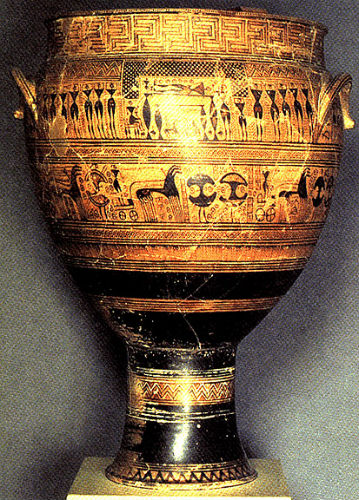
「幾何学様式」Geometric style Greek Dipylon
Krater with a prothesis scene (upper tier) and
a procession of chariots and foot soldiers (lower tier).
Bottega del Pittore di Hirschfeld (attr.), Cratere funerario ateniese,
Tardo geometrico I, 750-735 a.C., h 108.3 cm.
New York, Metropolitan Museum of Art 14.130.14
http://humanitieslab.stanford.edu/113/655(スタンフォード大学Metamedia) ギリシア考古学 The Neolithic and the Bronze Age The Progression of Greek Pottery
![]() ニューヨークにあるものTerracotta krater Metropolitan Museum of Art 14.130.14は、脚がジグザグ文
。赤い色がよく残っているようです。
ニューヨークにあるものTerracotta krater Metropolitan Museum of Art 14.130.14は、脚がジグザグ文
。赤い色がよく残っているようです。
Types of Greek Pottery, by Shape(形によるスタイル)の下にある、Styles of Greek Pottery, by time period(時代によるスタイル)の引用紹介
Geometric Art in Ancient Greeceメトロポリタン美術館Heilbrunn Timeline of Art Historyhttp://www.metmuseum.org/toah/
The roots of Classical Greece lie in the Geometric period of about ca. 900 to 700 B.C., a time of dramatic transformation that led to the establishment of primary Greek institutions.
The Greek city-state (polis) was formed, the Greek alphabet was developed, and new opportunities for trade and colonization were realized in cities founded along the coast of Asia Minor, in southern Italy, and in Sicily.
The Geometric style…introduces many patterns…Geometric also introduces human and semi-human figures, first singly, then in groups which make meaningful narratives.
–
(古代ギリシャの起源は、紀元前900年から700年頃の幾何学様式時代に遡ります。この時代は劇的な変革の時代であり、ギリシャの主要な制度が確立されました。
ギリシャの都市国家(ポリス)が形成され、ギリシャ文字が開発され、小アジア沿岸、南イタリア、シチリア島に築かれた都市で新たな貿易と植民地化の機会が生まれました。
幾何学様式は…多くのパターンを導入しました…幾何学様式はまた、人間や半人間の姿を、最初は単独で、そして後に意味のある物語を構成する集合体として導入しました。)
Classical Art Research Centre(古典芸術研究センター)
http://www.beazley.ox.ac.uk/, articles on Early, Middle, and Late Geometric pottery
Ancient Greek Thesaurus
http://www.greek-thesaurus.gr/geometric-periods-pottery.html
西洋建築史⇒「建築-美と空間」⇒パルテノンのフリーズの解釈、 ⇒フリーズのギガントマキアーと蛇
MENU@美学のおさらい:芸術学(講座美学) 美学(西洋美学のエッセンス) 芸術の分類体系 百科全書派 18世紀西洋美術 廃墟の画家(ユベール・ロベール) ニースの近現代芸術 映画(芸術)/フランスの美術館円柱フェチ:円柱 柱頭芸術:フランスの芸術(建築美) プロヴァンスの修道院(ロマネスク) 仏蘭西の大聖堂(ゴシック) 「建築家」 建築(芸術) 大聖堂の精神 中世の彫刻美 プレロマネスク 建築600選(歴史) 神殿(イメージの博物誌)
first updated 2015/10/28 Lastmodefied2025/09/06
